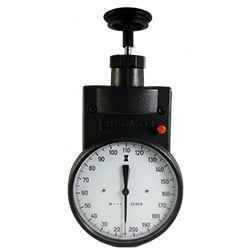Tachometer Fundamentals: Everything You Required to Know for Accurate Readings
Tachometer Fundamentals: Everything You Required to Know for Accurate Readings
Blog Article
Discovering the Functions and Benefits of a Tachometer: A Comprehensive Guide for Auto Enthusiasts
From supplying real-time information on engine rate to aiding in maximizing equipment shifts, the tachometer serves as more than just a dial on the dashboard. Its diverse functions not just improve driving experience but also play a critical function in preserving engine health and wellness and performance.
Comprehending the Essentials of a Tachometer
In the world of auto instrumentation, recognizing the essentials of a tachometer is essential for any kind of car lover looking to delve right into the complexities of engine performance monitoring. A tachometer, usually presented on the dashboard of a vehicle, measures the engine's transformations per minute (RPM)
Tachometers typically have a scale noted in transformations per minute, with a redline indicating the optimum rate at which the engine can securely run (tachometer). This info is essential for preventing engine damage and enhancing gear changing for manual transmissions. Furthermore, tachometers can aid in diagnosing engine concerns such as misfires or a falling short ignition system by spotting irregular RPM analyses
Relevance of Keeping Track Of Engine Rate

Keeping an eye on engine rate is a critical facet of lorry maintenance and performance optimization for automobile lovers and experts alike. The engine speed, gauged in transformations per minute (RPM), shows how fast the engine's crankshaft is revolving. By keeping a close eye on the RPM, drivers can ensure that the engine is running within the ideal variety, preventing possible damages from over-revving or stalling. Checking engine speed is especially vital during gear shifts, as it helps motorists establish the correct time to alter gears for smooth acceleration and effective fuel usage.
Additionally, tracking engine speed can additionally provide useful understandings right into the general wellness of the car. Generally, checking engine rate with a tachometer is a basic practice that can enhance driving performance, extend engine life, and guarantee a much safer and much more pleasurable driving experience.
Enhancing Performance Through Gear Shifts
Optimizing performance through tactical equipment changes is an essential aspect of maximizing an automobile's performance and power result. Appropriate equipment shifting ensures that the engine runs within its ideal power band, permitting smooth acceleration and improved gas economic climate. When moving equipments, it is crucial to take note this contact form of the engine rate showed on the tachometer. By checking the engine changes per minute (RPM), motorists can identify one of the most favorable minutes to upshift or downshift for optimal efficiency.

To attain peak efficiency through gear changes, chauffeurs must practice smooth and timely transitions in between equipments, matching engine rate with roadway speed to harness the full potential of their automobile's powertrain.
Taking Full Advantage Of Performance With a Tachometer
Understanding the art of equipment moving in high-performance vehicles not only enhances driving experience yet also plays a crucial function in taking full advantage of effectiveness with a tachometer. tachometer. By paying very close attention to the tachometer readings, chauffeurs can optimize their equipment changes to operate within the engine's most efficient variety. When increasing, changing equipments at the appropriate RPM suggested by the tachometer can stop the engine from straining or underperforming, resulting in enhanced fuel performance and total performance
Furthermore, a tachometer helps vehicle drivers stay clear of unnecessary revving, which not only loses fuel yet also puts unnecessary stress on the engine. Continually keeping track of the tachometer while driving permits smoother gear shifts, decreasing damage on the transmission system with time.

Advanced Tips for Tachometer Use
To dig right into advanced suggestions for tachometer application, take into consideration including the usage of shift lights. Change lights are visual indicators that illuminate when it's time to move gears based on engine changes per minute (RPM), enabling for seamless equipment modifications without frequently checking the tachometer. By fine-tuning change factors and establishing advising limits, motorists can optimize acceleration and engine performance while lessening the danger of over-revving.
Final Thought
Finally, the tachometer functions as a critical tool for car fanatics to keep track of engine speed, improve performance through equipment changes, and make the most of efficiency. By comprehending the functions and benefits of a tachometer, chauffeurs can enhance their driving experience and prolong the lifespan of their automobile. Utilizing sophisticated pointers for tachometer application can better boost driving skills and general performance when traveling.
Report this page